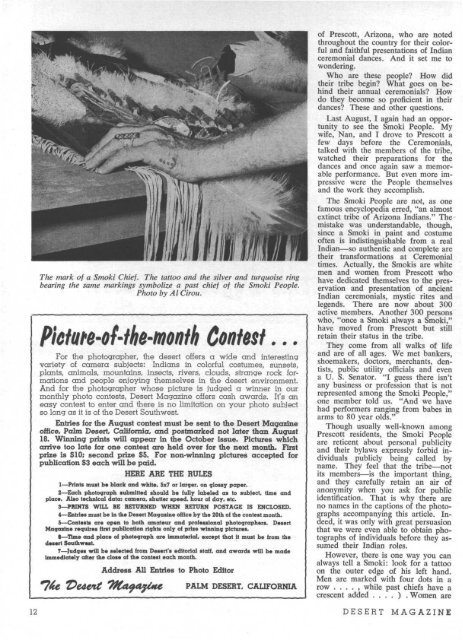1 - Desert Magazine of the Southwest
1 - Desert Magazine of the Southwest
1 - Desert Magazine of the Southwest
Create successful ePaper yourself
Turn your PDF publications into a flip-book with our unique Google optimized e-Paper software.
The mark <strong>of</strong> a Smoki Chief. The tattoo and <strong>the</strong> silver and turquoise ring<br />
bearing <strong>the</strong> same markings symbolize a past chief <strong>of</strong> <strong>the</strong> Smoki People.<br />
Photo by Al Cirou.<br />
Pictute-<strong>of</strong>-<strong>the</strong>-month Contest...<br />
For <strong>the</strong> photographer, <strong>the</strong> desert <strong>of</strong>fers a wide and interesting<br />
variety <strong>of</strong> camera subjects: Indians in colorful costumes, sunsets,<br />
plants, animals, mountains, insects, rivers, clouds, strange rock formations<br />
and people enjoying <strong>the</strong>mselves in <strong>the</strong> desert environment.<br />
And for <strong>the</strong> photographer whose picture is judged a winner in our<br />
monthly photo contests, <strong>Desert</strong> <strong>Magazine</strong> <strong>of</strong>fers cash awards. It's an<br />
easy contest to enter and <strong>the</strong>re is no limitation on your photo subject<br />
so long as it is <strong>of</strong> <strong>the</strong> <strong>Desert</strong> <strong>Southwest</strong>.<br />
Entries for <strong>the</strong> August contest must be sent to <strong>the</strong> <strong>Desert</strong> <strong>Magazine</strong><br />
<strong>of</strong>fice. Palm <strong>Desert</strong>, California, and postmarked not later than August<br />
18. Winning prints will appear in <strong>the</strong> October issue. Pictures which<br />
arrive too late for one contest are held over for <strong>the</strong> next month. First<br />
prize is $10; second prize $5. For non-winning pictures accepted for<br />
publication $3 each will be paid.<br />
HERE ARE THE RULES<br />
1—Prints must be black and white. 5x7 or larger, on glossy paper.<br />
2—Each photograph submitted should be fully labeled as to subject, time and<br />
place. Also technical data: camera, shutter speed, hour <strong>of</strong> day, etc.<br />
3—PRINTS WILL BE RETURNED WHEN RETURN POSTAGE IS ENCLOSED.<br />
4—Entries must be in <strong>the</strong> <strong>Desert</strong> <strong>Magazine</strong> <strong>of</strong>fice by <strong>the</strong> 20th <strong>of</strong> <strong>the</strong> contest month.<br />
5—Contests are open to both amateur and pr<strong>of</strong>essional photographers. <strong>Desert</strong><br />
<strong>Magazine</strong> requires first publication rights only <strong>of</strong> prize winning pictures.<br />
6—Time and place <strong>of</strong> photograph are immaterial, except that it must be from <strong>the</strong><br />
desert <strong>Southwest</strong>.<br />
7—Judges will be selected from <strong>Desert</strong>'s editorial staff, and awards will be made<br />
immediately after <strong>the</strong> close <strong>of</strong> <strong>the</strong> contest each month.<br />
Address All Entries to Photo Editor<br />
Z>e4c*t t 7HaQ4$i*e PALM DESERT. CALIFORNIA<br />
<strong>of</strong> Prescott, Arizona, who are noted<br />
throughout <strong>the</strong> country for <strong>the</strong>ir colorful<br />
and faithful presentations <strong>of</strong> Indian<br />
ceremonial dances. And it set me to<br />
wondering.<br />
Who are <strong>the</strong>se people? How did<br />
<strong>the</strong>ir tribe begin? What goes on behind<br />
<strong>the</strong>ir annual ceremonials? How<br />
do <strong>the</strong>y become so pr<strong>of</strong>icient in <strong>the</strong>ir<br />
dances? These and o<strong>the</strong>r questions.<br />
Last August, I again had an opportunity<br />
to see <strong>the</strong> Smoki People. My<br />
wife, Nan, and I drove to Prescott a<br />
few days before <strong>the</strong> Ceremonials,<br />
talked with <strong>the</strong> members <strong>of</strong> <strong>the</strong> tribe,<br />
watched <strong>the</strong>ir preparations for <strong>the</strong><br />
dances and once again saw a memorable<br />
performance. But even more impressive<br />
were <strong>the</strong> People <strong>the</strong>mselves<br />
and <strong>the</strong> work <strong>the</strong>y accomplish.<br />
The Smoki People are not, as one<br />
famous encyclopedia erred, "an almost<br />
extinct tribe <strong>of</strong> Arizona Indians." The<br />
mistake was understandable, though,<br />
since a Smoki in paint and costume<br />
<strong>of</strong>ten is indistinguishable from a real<br />
Indian—so au<strong>the</strong>ntic and complete are<br />
<strong>the</strong>ir transformations at Ceremonial<br />
times. Actually, <strong>the</strong> Smokis are white<br />
men and women from Prescott who<br />
have dedicated <strong>the</strong>mselves to <strong>the</strong> preservation<br />
and presentation <strong>of</strong> ancient<br />
Indian ceremonials, mystic rites and<br />
legends. There are now about 300<br />
active members. Ano<strong>the</strong>r 300 persons<br />
who, "once a Smoki always a Smoki,"<br />
have moved from Prescott but still<br />
retain <strong>the</strong>ir status in <strong>the</strong> tribe.<br />
They come from all walks <strong>of</strong> life<br />
and are <strong>of</strong> all ages. We met bankers,<br />
shoemakers, doctors, merchants, dentists,<br />
public utility <strong>of</strong>ficials and even<br />
a U. S. Senator. "I guess <strong>the</strong>re isn't<br />
any business or pr<strong>of</strong>ession that is not<br />
represented among <strong>the</strong> Smoki People,"<br />
one member told us. "And we have<br />
had performers ranging from babes in<br />
arms to 80 year olds."<br />
Though usually well-known among<br />
Prescott residents, <strong>the</strong> Smoki People<br />
are reticent about personal publicity<br />
and <strong>the</strong>ir bylaws expressly forbid individuals<br />
publicly being called by<br />
name. They feel that <strong>the</strong> tribe—not<br />
its members—is <strong>the</strong> important thing,<br />
and <strong>the</strong>y carefully retain an air <strong>of</strong><br />
anonymity when you ask for public<br />
identification. That is why <strong>the</strong>re are<br />
no names in <strong>the</strong> captions <strong>of</strong> <strong>the</strong> photographs<br />
accompanying this article. Indeed,<br />
it was only with great persuasion<br />
that we were even able to obtain photographs<br />
<strong>of</strong> individuals before <strong>the</strong>y assumed<br />
<strong>the</strong>ir Indian roles.<br />
However, <strong>the</strong>re is one way you can<br />
always tell a Smoki: look for a tattoo<br />
on <strong>the</strong> outer edge <strong>of</strong> his left hand.<br />
Men are marked with four dots in a<br />
row . . . . , while past chiefs have a<br />
crescent added ....). Women are<br />
12 DESERT MAGAZINE

















